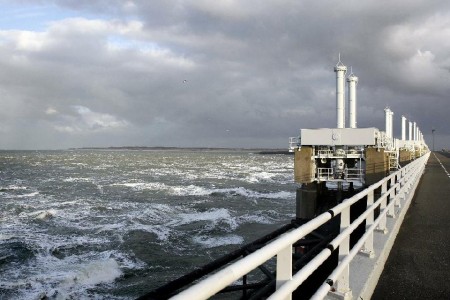September 19, 2014 – On two sides of the planet, two countries describe approaches to dealing with a consequence of climate change – rising sea levels. One has unveiled a multi-decade plan to counter this coastal threat. The other isn’t even acknowledging the issue and instead an independent, not-for-profit, crowd-funded group is issuing independent findings.
The first country is The Netherlands.
How The Netherlands intends to deal with rising sea levels is pretty clear. The country plays close attention to the water off its shores and has a history of holding back the sea (see the picture to the left below, courtesy of Bas Czerwinski, AFP). With water rising 5 millimeters (approximately 0.2 inches) per year through its new Delta Plan the Dutch will spend $25 billion U.S. over three decades to build new sea barriers and strengthen existing ones. Currently one in three dykes does not meet current safety standards and as a result would fail during a storm surge as the seas rise. These vulnerable barriers will be reinforced or rebuilt, a total of 200 in all. Along the Rhine and Maas Rivers the plan is to reinforce all dykes and surge barriers.
In additon the Dutch intend to waterproof their cities by ensuring that there is space to allow water to flow around and away from them during inundations. Lots of new homes will be designed to float.
The Netherlands remembers disasters in the 1950s that led to the death of more than 1,000 of its citizens. It has no intention of being a victim again.
And then there is Australia.
The Australian government is defunding climate change research. Out of sight, out of mind. But the Climate Council, founded as separate from the government after much of the department of the environment got axed, continues to provide reports to the Australian people. In its latest it examines threats to Australia’s major population centers, all along the coast. These are the cities of Sydney, Melbourne, Hobart, Adelaide, Perth, Darwin and Brisbane and all are at risk to coastal inundation as ocean levels rise.
With a 0.4 meter (1.3 foot) rise anticipated by 2100, based on a 2 Celsius (3.6 Fahrenheit) degree rise in mean global temperatures, Sydney (seen in the picture below on the right, courtesy of Mick Tsikas/AAP), and much of the coastal areas of the states of Queensland and Victoria would be subject to frequent coastal flooding. A rise in sea levels even half that height equates to upwards of $2 billion in damages to coastal infrastructure and private property. But if temperatures rise by twice the amount which could happen if carbon emission mitigation is not adopted globally, the Council forecasts an even larger surge in sea levels rising by more than 1.1 meters (3.6 feet). In these circumstances, the Council’s worst case scenario states Australia will experience $226 billion in property losses from coastal flooding and 31,000 kilometers (19,000 miles) of coastline will be vulnerable to severe erosion.
Some Australian cities are using Council research to assist them in planning. Recently Brisbane built its newest airport runway on higher ground knowing that its original plans would have led to potential inundation from the Pacific Ocean. But Brisbane is the exception and not the rule.





















[…] Rising Tides – Mitigation versus Consternation […]
[…] Rising Tides – Mitigation versus Consternation https://www.21stcentech.com/rising-tides-mitigation-consternation/ […]